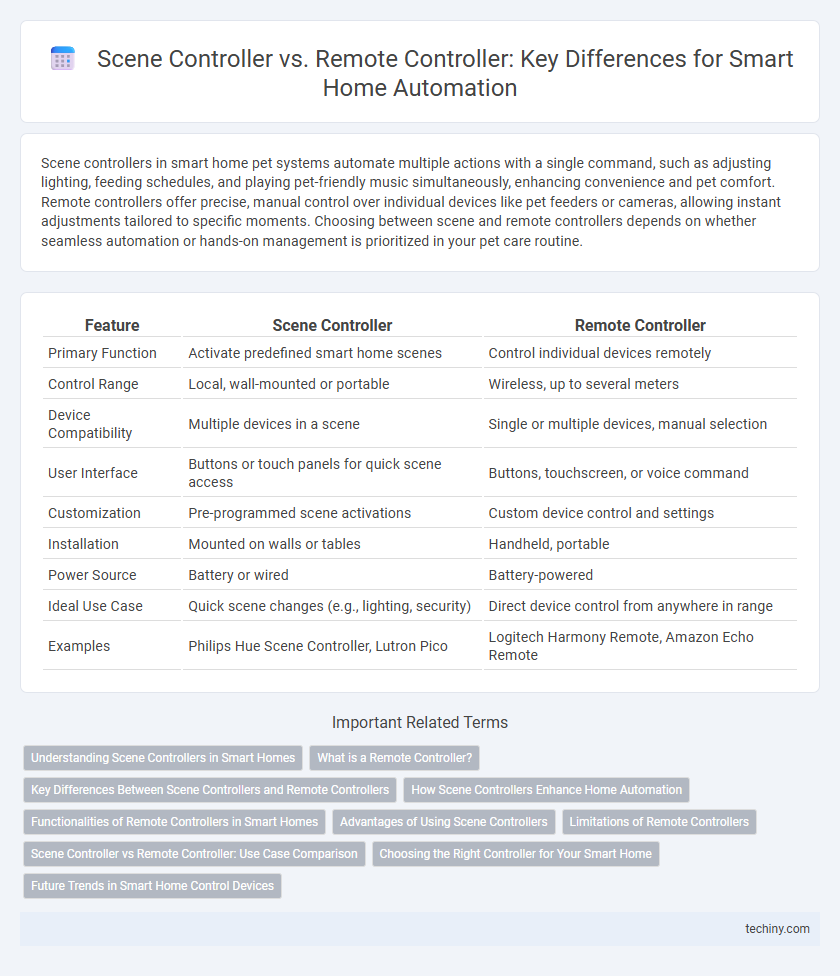Scene controllers in smart home pet systems automate multiple actions with a single command, such as adjusting lighting, feeding schedules, and playing pet-friendly music simultaneously, enhancing convenience and pet comfort. Remote controllers offer precise, manual control over individual devices like pet feeders or cameras, allowing instant adjustments tailored to specific moments. Choosing between scene and remote controllers depends on whether seamless automation or hands-on management is prioritized in your pet care routine.
Table of Comparison
| Feature | Scene Controller | Remote Controller |
|---|---|---|
| Primary Function | Activate predefined smart home scenes | Control individual devices remotely |
| Control Range | Local, wall-mounted or portable | Wireless, up to several meters |
| Device Compatibility | Multiple devices in a scene | Single or multiple devices, manual selection |
| User Interface | Buttons or touch panels for quick scene access | Buttons, touchscreen, or voice command |
| Customization | Pre-programmed scene activations | Custom device control and settings |
| Installation | Mounted on walls or tables | Handheld, portable |
| Power Source | Battery or wired | Battery-powered |
| Ideal Use Case | Quick scene changes (e.g., lighting, security) | Direct device control from anywhere in range |
| Examples | Philips Hue Scene Controller, Lutron Pico | Logitech Harmony Remote, Amazon Echo Remote |
Understanding Scene Controllers in Smart Homes
Scene controllers in smart homes enable users to activate multiple devices or settings with a single command, streamlining the management of complex automation scenarios. Unlike remote controllers that typically operate individual devices, scene controllers orchestrate lighting, climate, and security systems simultaneously to enhance comfort and energy efficiency. Their integration with voice assistants and smartphone apps further amplifies convenience by offering centralized control over diverse smart home functions.
What is a Remote Controller?
A Remote Controller in a smart home system is a handheld device that allows users to operate various smart devices such as lights, thermostats, and entertainment systems from a distance. It typically features buttons, touchscreens, or voice control functionality to provide convenient access without needing to use a smartphone or smart hub. Remote Controllers enhance user experience by offering quick and intuitive control over multiple smart home components.
Key Differences Between Scene Controllers and Remote Controllers
Scene controllers in smart homes are designed to activate multiple devices or settings simultaneously through pre-programmed scenarios, offering seamless automation for lighting, climate, and security. Remote controllers primarily provide manual, device-specific control, allowing users to adjust individual appliances or functions on demand. Unlike remote controllers, scene controllers enhance convenience by enabling one-touch activation of complex sequences, improving energy efficiency and user experience.
How Scene Controllers Enhance Home Automation
Scene controllers enhance home automation by enabling users to activate multiple smart devices simultaneously with a single command, streamlining control over lighting, climate, and security systems. Unlike remote controllers that typically manage one device at a time, scene controllers provide customized presets that adjust various smart home components to desired settings instantly. This integration boosts convenience and energy efficiency in connected homes.
Functionalities of Remote Controllers in Smart Homes
Remote controllers in smart homes offer versatile functionalities including centralized management of multiple devices, customizable scene activation, and real-time status monitoring. They enable users to adjust lighting, climate, security, and entertainment systems remotely, enhancing convenience and energy efficiency. Integration with voice assistants and mobile apps further expands control options beyond traditional scene activation.
Advantages of Using Scene Controllers
Scene controllers enhance smart home automation by enabling users to execute multiple device actions simultaneously with a single command, improving convenience and efficiency. They offer customizable presets that tailor lighting, climate, and security settings to specific moods or activities, optimizing energy use and user comfort. Unlike remote controllers, scene controllers integrate seamlessly with voice assistants and smart hubs, providing a unified and intuitive home control experience.
Limitations of Remote Controllers
Remote controllers in smart home systems often face limitations such as range restrictions, dependency on line-of-sight, and limited customization of scenes. These devices may lack the flexibility to control multiple devices simultaneously or adapt to complex automation scenarios. Scene controllers provide enhanced functionality by enabling seamless, one-touch activation of multiple devices, overcoming the constraints inherent in traditional remote controllers.
Scene Controller vs Remote Controller: Use Case Comparison
Scene controllers excel in automating predefined smart home environments, allowing users to trigger multiple device actions simultaneously with a single command, enhancing convenience for routines like morning wake-up or movie nights. Remote controllers offer precise, manual control over individual devices, ideal for on-the-fly adjustments such as changing light brightness or thermostat settings. Choosing between a scene controller and a remote controller depends on whether the priority is automation of complex scenarios or real-time device management.
Choosing the Right Controller for Your Smart Home
Scene controllers offer customizable automation by triggering multiple devices simultaneously based on predefined settings, ideal for creating specific moods or routines in your smart home. Remote controllers provide versatile, handheld access to individual devices or scenes, allowing users to manage lighting, climate, and entertainment systems from anywhere in the home. Selecting between a scene controller and a remote controller depends on whether you prioritize automated, hands-free operation or manual, on-demand control for your smart home environment.
Future Trends in Smart Home Control Devices
Scene controllers are evolving to integrate AI-driven automation, enabling predictive adjustments based on user habits, while remote controllers are shifting towards voice and gesture recognition for enhanced accessibility. Future trends in smart home control devices emphasize seamless interoperability with IoT ecosystems, leveraging edge computing to reduce latency and improve real-time responsiveness. Enhanced security protocols and customizable user interfaces will further distinguish scene controllers and remote controllers in adaptive smart home environments.
Scene Controller vs Remote Controller Infographic

 techiny.com
techiny.com